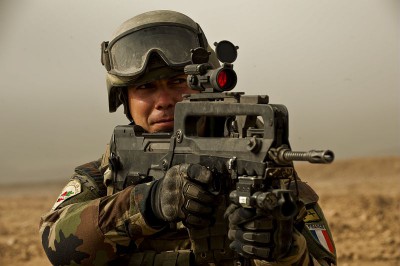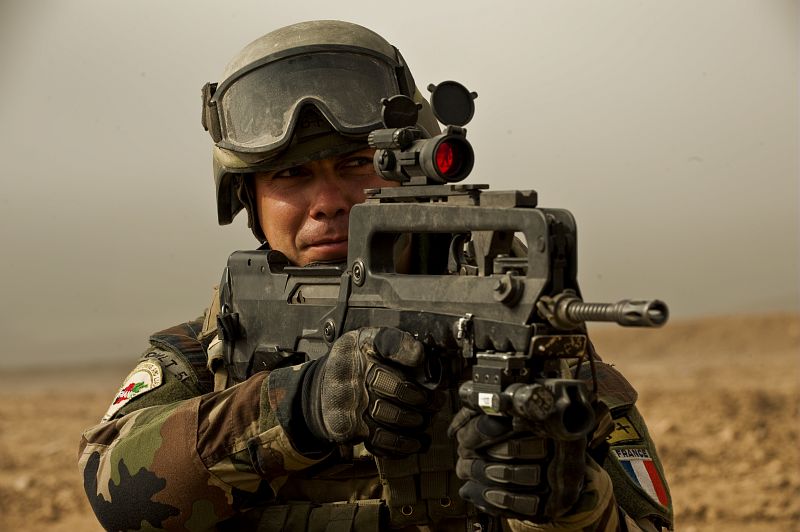Buy French to replace Famas: is it possible?

(B2) To replace the FAMAS, let's buy a French rifle! This is the meaning of the campaign led by two French deputies, one from the Republicans of the Rhône, Philippe Meunier and the other from the PCF du Nord, Jean-Jacques Candelier. They wrote, at the beginning of October, a Letters, crying wolf on the opening to all winds of public arms markets to "foreigners". A letter that flatters penny nationalism, where everything that is not French is "foreign" - including Europeans - and which surfs on the legitimate emotion of the end of FAMAS, the assault rifle of the Manufacture d'armes de Saint-Etienne (now closed). Quite a symbol. But the arguments used are closer to false advertising...
The first argument used is the exclusion of a national solution
« Everything was done in the tender procedure to exclude, in fact, any national solution. This is not acceptable. » they indicate
In 2014, the Ministry of Defense launched a call for tenders to renew the fleet of FAMAS, rifles of the French army. A "beautiful" market since it concerns 90.000 weapons, ammunition, accessories and the support device and is spread over 14 years. A restricted call for tenders, as authorized by community regulations – the 2009 directive on public defense procurement – but launched at European level. Quite simply because there is no (more) national production of assault rifles. "Community preference" does apply (1). Those who are excluded are not national producers but operators outside the European Union, as the call for tenders indicates.
“This procedure is not open to economic operators from countries outside the European Union or the European Economic Area”
The Ministry of Defense's call for tenders even went quite far since it specified that the reality of production should also be located in the European Union. The contractor must justify:
1 ° " that the means of production, essential for the manufacture of barrels and bolt heads of assault rifles, are currently located and implemented on the territory of the EU or the EEA (European Economic Area)”. The manufacturer must provide the list of these means, the address of their place of establishment and the list of productions carried out during the last three years »
2nd same " for sources of supply, essential for the manufacture of barrels and bolt heads for assault rifles »
3nd same " for the assembly line and the means of the final (receipt) of the assault rifles ».
In addition, he must demonstrate certain abilities, for example " its ability to execute, over a long period and for large quantities of weapons, contracts for the supply of assault rifles including documentary services, in particular through the following axes: quantities of weapons delivered, duration of the contracts, organization , workforce, management principles, risk management ».
This is precisely the problem. Because the famous colt of the two deputies, the "French" Verney-Carron, established in Saint-Etienne (2), does not meet these conditions. Quite simply because he does not have this product to his catalog and that if it did make one, it would be under a technology transfer agreement with Israeli industrialist, Israel Weapon Industry (IWI), maker of the legendary Uzi and the more recent Galil or Tavor. In fact of "made in France" and national rifle manufacturer, we are rather faced with what is called a European false nose. That is to say a "foreign" manufacturer who finds an outlet on national soil. We understand better why the Ministry of Defense prefers to include in its call for tenders manufacturers, licensed assault rifles, who have already proven themselves on the European or even national market. Five manufacturers currently remain in competition: the German Heckler & Koch (with the HK 416), the Belgian FN Herstal (with its SCAR), the Italian Beretta (with its ARX 160), the Swiss Swiss Arms (which notably produces the SIG 550) and Croatian HS Produkt (with VHS2). Assessments are ongoing. The result of the contract should be notified in December 2016 for a current purchase in 2017 and the full equipment of the forces in 2018. Certain spin-offs from this contract are also not excluded for certain French companies, such as Nexter Mechanics based in Tulle (Corrèze ) or Manurhin based in Mulhouse.
As for the second assertion of the two deputies:
“As far back as the history of our armies goes, the French infantryman has always been equipped with a weapon made on our soil. »
It comes up against certain realities which have undoubtedly escaped our representatives of the nation. It has been a long time since many units have been equipped with rifles manufactured outside France. The HK 416 thus replaced the FAMAS in the Air Force, starting with the parachute commandos, the special helicopter squadron of Cazaux before becoming generalized throughout the army. And as my colleague from the mammoth, fine connoisseur of equipment, this is not the only example. " The Army acquired SCAR assault rifles (from the FN). And the forces deployed abroad had also benefited from SiG (Swiss) assault rifles in the 70s, for lack of anything better in the national heritage. "Ditto for the COS, the special operations command, which has staffed its staff" lack of equivalent national products of Glock and HK pistols, HK416 and 417, Dillon's M134D miniguns » etc.
The ambition through the establishment of European calls for tenders is not to open up to all winds - as the authors of the letter claim - but to create a European defense market (the one this is still in its infancy) and thereby consolidate national industries. The reaction of withdrawal into oneself can be understood. But, in the end, she turns out to be suicidal. Because the national markets are today too small to sustain an industrialist. The example of the FAMAS shows it, to perfection... A weapon that is not widely sold for export, which is not cheap enough or exceptional enough to arouse external enthusiasm. And, on arrival, a shareholder (the State) who refuses to absorb the losses, and closes the company (3). By manufacturing alone, without looking for European alliances, the French have shot themselves in the foot.
(NGV)
(1) Community preference has not been included in a mandatory manner in European regulations, despite French requests. But it is not prohibited. It is up to the member states to apply it or not.
(2) Another project, led by Etienne Faverjon, the gun Aries, had started to be talked about before sinking. The entrepreneur, also based in Saint-Etienne, was arrested for arms trafficking (read on Le Parisien or Progress) and his company, France-Armes, was subsequently put into liquidation. We understand why the State order services have some doubts about last-minute vocations...
(3) One can wonder why the Belgian FN Herstal, which at the same time had the same shareholder (GIAT), before regaining its independence (with the public shareholding of the Walloon Region) has found more positive colors when the St Etienne factory closed its doors.


